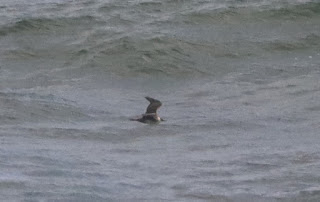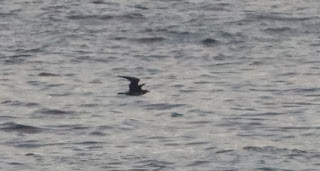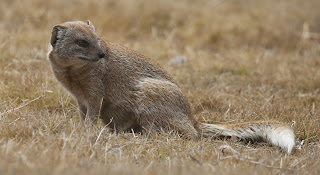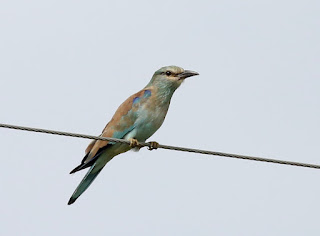We arrived back home early afternoon on 2nd February, after our little adventure on the high seas. It was all about unpacking & getting stuff sorted in the house. However, I managed an evening sea-watch & recorded 112 Arctic & 5 Pomarine Skuas. Late on 2 European Storm Petrels were seen.
Pomarine Skua
Poor quality photos because of a combination of
extreme distance & poor light.
An early morning sea-watch on 3rd produced another European Storm Petrel. The wind started to freshen & a mid-day sea-watch was productive with a White chinned Petrel; a Southern Giant Petrel; 7 Giant Petrel sp.; another European Storm Petrel & an adult Sabine's Gull feeding offshore. The evening sea-watch was also productive with 142 Arctic; 22 Pomarine Skuas; adult Sabine's Gull; 4 White chinned Petrel; one Northern & one Southern Giant Petrel; 14 Giant Petrel sp. & a Sooty Shearwater. Quite a haul for this time of year!
Common Swift
Early morning of the 6th February saw over 190 Common Swifts hawking over the sea, in the early morning. Slightly later in the morning a gigantic flock of 26,000 Cape Cormorants was quite a spectacle!
I then went on a birding/cycle ride around the village, which was very pleasant. The highlight being another 3 Common Swifts. Nothing of note was seen on the evening sea-watch with only 2 Arctic Skuas making an appearance.
Uilenkraal Estuary
The 7th February was a nice sunny & relatively calm day, so I visited the Uilenkraal Estuary. I had been wanting to visit for a while, but it had just been too windy to keep the tripod & scope still! Wader numbers were down on previous visits, but the Greater Sand Plover was still present & I found a winter plumaged Red Knot, which is a pretty scarce species in this part of the world.
White fronted Plover
Other highlights included:
36 Grey Plover; 2 Kittlitz's Plover; 58 White fronted Plover; 180 Common Ringed Plover; 47 Whimbrel; a Ruddy Turnstone; 122 Curlew Sandpiper; 109 Little Stint; a Common Greenshank; 630 Great crested Tern & 141 Sandwich Terns roosting on the sandbanks. It was a very pleasant afternoon birding, in good weather.
A small group of Arctic Skuas on the sea.
The evening sea-watch was quite productive with 12 Pomarine Skua; a fantastic 344 Arctic Skua & 2 African Penguin on the sea.
Cape Grassbird
A Cape Grassbird was singing in the fynbos opposite the house, which is unusual here.
White faced Whistling Duck
I decided to do a bit of a birding tour around some sites around The Overberg on 8th February. Got up early but it was thick fog! So had to wait a while for it to clear. My first stop was at a small dairy farm on the R317 dirt road. This is a favorite of mine, because it has wet grassland habitat & a productive small farm dam right next to the roadside. The dam held an incredible 48 White faced Whistling Duck & 11 Red billed Duck. Both very high counts for this area. Unfortunately the grassland had started to dry out & so was not as productive as earlier in the year.
The un-named dam!
My next stop was the large dam on the Bredasdorp road. What a shock! All the breeding grebes & terns had vanished! Even though there was still plenty of water, the dam had started to dry out. I spent a nice & fairly productive 30 minutes there. Saw 41 species, the highlight being a male Quail-finch was flew over calling. A bit of a rarity in these parts.
A quick stop in the small town of Agulhas produced a small colony of Little Swifts breeding. This is a rare bird in these parts & I don't think anyone knows about this location. A saw a first winter Roseate Tern roosting with other terns on the rocks, but it was a little distant for a photograph.
Part of the flock of Great White Pelicans.
On my way back through the Agulhas National Park I received a nice surprise with a flock of 84 Great White Pelicans circling over the road. Always great to see this species & it appears to be doing well in these parts.
Large billed Lark
I had a brief visit to the farmland on the way to Reitfontein, but everything was so dry & far less species were present than on my last visit. However I did see an Agulhas Long billed Lark, but it was distant. Far more obliging was the Large billed Lark sat on a nearby rock in an open field. I failed to find Agulhas Clapper Larks which had been numerous on my previous visits.
Pomarine Skua
The evening sea-watch was very productive with 18 Pomarine & 260 Arctic Skuas coming in to roost on the sea. An added bonus were 2 adult Sabine's Gulls both sat on the sea & flying around at dusk. Always great to see this species.
A small portion of the Cape Cormorant flock
feeding in the bay.
Southern Giant Petrel
The evening sea-watch on 9th February was excellent. 8 Pomarine & 339 Arctic Skuas came in. 4 Giant Petrel sp. were flying around & one Southern Giant Petrel. A Damara Tern flew by (quite a rarity here). However, just before dusk I spotted a group of 13 adult Sabine's Gulls flying low over the sea & eventually landing. I think they roosted on the calm waters in the bay, as they came in so late.
Us, with Kai & Claudia
We met Kai & Claudia in northern Namibia in October last year. They are on an extended six month trip around southern Africa. They popped in to see us as they are staying locally for a few days in order to do some kite-surfing. We had a lovely evening together. It was good to see them again.
I should have been up at the crack of dawn on 10th February but I wasn't, not starting the sea-watch until just after 8 am. This was a big mistake! There was little or no wind, the sea was calm but with large swells & there were birds everywhere! What would I have seen if I had been watching from dawn? It was a very enjoyable sea-watch in nice conditions sat on the veranda. The first thing I noticed were the Skuas. There are rarely if ever any Skua species here in the mornings. But today 43 Arctic & 3 Pomarine were around, with most flying west later in the morning. In the calm conditions I spotted 3 African Penguins sat on the sea. 8 Giant petrel sp. were flying around (impossible to get a definitive identification in the available light). 30 Cape Gannet passed west, by far the most I have ever seen from here. 3 Sooty Shearwaters also flew west, but best of all the Sabine's Gulls were still present! At least 15 were recorded sitting on the sea & occasionally getting off the surface for a fly around. They were present for well over an hour, but kept at a great distance, too far for any meaningful photos. What a fabulous mornings birding!
Male Southern Double collared Sunbird
The evening sea-watch was a little quiet. A Northern Giant Petrel was identified & 4 Giant Petrel sp. were also seen. It was a beautiful calm evening with a correspondingly flat sea so 14 African Penguins could be picked out. They are probably always there, but impossible to spot them in the huge seas. 63 Arctic & 16 Pomarine Skuas were noted.
Southern Giant Petrel
The morning sea-watch on the 11th February was very interesting. It was a flat calm sea but there were plenty of birds around. My first Sub-antarctic Skua of the season was seen, with 3 Pomarine & 43 Arctic Skuas noted. This was the first time I have seen good numbers of Skuas in the morning. usually there are none around, or just a couple in the bay. Ten Sabine's Gull were also feeding offshore, I presume some of the same birds as the previous evening? 13 Giant Petrel sp. were around, some just loafing on the surface of the sea. One Southern Giant Petrel was identified.
But it was the Sooty Shearwaters that stole the show with 531 birds heading west, in very little wind. I presume that they will just got more frequent as summer comes to a close? A White chinned Petrel was also noteworthy.
In the evening we went to Klein Paradise just on the edge of Pearly Beach. We enjoyed a nice walk around the dam but as darkness fell we heard Fiery necked Nightjar & both Spotted Eagle & Barn Owls! A major plus for the next days bird race! This is the first time I have recorded the Nightjar in the Cape.
It is dark, mainly because it is the middle of the night! We are up at 3.30 am on 12th February, for The Big Birding Day! We are of course several weeks late, to do a birding big day, as many species have stopped calling now. But it is the only time we have available. By 4 am we are driving towards the dam & marsh on the Bradasdorp Road. A Barn Owl silently hunts along side the road. We are all on time & we meet up with Wim, his daughter Lona-lize & Eugene. A pair of Crowned Plovers with three chicks, are in he headlights. We stop by the marsh & listen, as very slowly night fades & the day unfolds. African Snipe calls, an excellent species to get, as does a Southern Black Bustard. We are off to a good start, with two tricky species under our belts. By the time we leave we are on 47 species, which is very good going.
Eugene, Lona-lize & Wim.
We then briefly visit another dam & we pick up 6 South African Shelduck, (which is of erratic occurrence here) & 16 Macoa Ducks. As we drive to Voelvlei we spot 57 Great White Pelicans. We also add tricky species like Malachite Kingfisher to the list. As we enter the Agulhas National Park we spot ostrich by the roadside & even more welcome were the two Chestnut banded Plovers! A scarce & hard to predict species in these parts.
Grey hooded Gull
We enter Struisbaii at around 10 am & start racking up coastal species. nothing rare, but all count as one for the day! I am disappointed as I can't pick out a Roseate Tern among the commoner tern species, out on the rocks. By the time we leave the area were on on 123 species, with Cape White- eye being the latest addition to our lists.
Eugene had got permission for us to visit the private garden at the Black Oystercatcher Wetland. This proves to be a master stroke as difficult species like Spotted Masked Weaver & Amethyst Sunbird fall into our notebooks. Unfortunately Eugene now has to leave us to go to work, but he has been a tremendous asset to the team.
By now it was hot & bird activity was low, but we pressed on visit a valley in Baardskeerdersbos. birding was tough but we managed to pull out species like lesser Honeyguide & African Dusky Flycatcher. By now we had broken the Agulhas Plains Area birding big day record (set at 130 species). We were on 136 species! Uilenkraals Estuary was a little quiet & we couldn't find the Greater Sand Plover in the time available! Drat! However we did spot an Osprey & several new wader species like Grey Plover, Little Stint & Curlew Sandpiper.
European Roller
A rarity here, but this year seems to be a bit
of an invasion for them.
We drove to Pearly Beach picking up a rare visitor: European Roller on the wires! How lucky was that? Then the small bit of freshwater in the dyke produced both Black Saw-wing & Pearly breasted Swallow! Both excellent day birds. A run down the beach flushed a Common Sandpiper of the rocks & behind our house was a Red winged Starling. We are now on 150 species.
Towards the end of the day on our balcony.
Then it was time to relax a little & conduct a bit of sea-watching which produced African Penguin & both Arctic & Pomarine Skuas. Our last stop, was just outside the village & we hit the jackpot with both Spotted Eagle Owl, Barn Owl & Fiery necked Nightjar all calling. It was time to call it a day, but what a day it had been! 156 species was the final total! An excellent effort by all concerned, considering the time of year.
The 13th February was a day for relaxing! But we did conduct an evening sea watch which produced 5 Sooty Shearwater, a White chinned Petrel, 2 Giant Petrel sp, Southern Giant Petrel, 191 Arctic & 10 Pomarine Skuas.
Gary & Di.
On 14th February Gary & Di paid a visit. Delana has known them a long time as they were originally from Namibia. However, they now live in the UK. It was great to see them again.
The 16th February was a day of driving to Caledon, for the new value for the Gofacet tent, Hermanus for the PCR tests & a bit off last minute shopping. We also picked up 2 European Rollers sat on wires along the way! A bit of an invasion for this supposedly rare visitor to these parts. The evening sea watch was very ordinary with only 24 Arctic & 9 Pomarine Skuas seen.
Early morning of the 17th February was the invasion of the Cape Cormorants! Around 33,000 were feeding opposite the house, which was quite a sight. We also got our test results, both negative, which is a huge relief & we are off to Mozambique!
A distant Southern Right Whale
Giant Petrel sp., being mobbed by
Arctic Skuas.
We returned home just before mid-night on 3rd March. It had been a long day of travelling! After a good nights rest, it was time to do the usual chores. Managed a sea-watch on the evening of 4th & it turned out to be a superb evenings viewing. First of all the Whales! Difficult to be exact in the counting but at least 2 Bryde's & 7 Southern Right Whales were present. Animals kept disappearing & re-appearing at regular intervals. But it was the Skuas that stole the show! It was a beautiful evening with a calm sea, the light was excellent. They just kept coming & coming! Final totals were 561 Arctic & a massive 57 Pomarine Skuas! Astonishing really! It will be interesting to see if they build up further before they start their migration north. Other notables included 2 Southern Giant Petrel, a Giant Petrel sp. & a Sooty Shearwater. What a welcome back present! Also this was the first time I had used my ne scope for sea-watching & I was very impressed. It has to be the best scope ever for this type of birding.
Up early on 5th March & out on the veranda. It was a superb morning weather wise, with lovely temperatures & a flat calm sea. The highlight of the morning was a super pod of around 130 Common Dolphins hunting far offshore (too far for photos). A Giant petrel sp., 3 Cory's Shearwaters & a Sooty Shearwater were feeding ahead of the pod. An immature Pomarine & 2 Arctic Skuas were hitting on the attendant terns. 4 African Penguins were much closer in. I was very pleased to see Cory's again from the house. I wonder when they start moving north to breed?
Crowned & Long tailed Cormorant.
Long tailed Cormorant is on the right.
The evening sea-watch as dominated by Skuas! Unfortunately the light was really poor with a bright spangly sea making life difficult. 726 Arctic & 19 Pomarine Skuas were seen. However, there could have been more Pomarine Skuas than that & I missed them because of the challenging conditions. This is a massive number of Arctic Skuas & is of considerable importance. I wonder when the numbers will peak & then drastically reduce, as they migrate north? One other thing of note was a Long tailed Cormorant sat on the rocks & associating with a Crowned Cormorant. This is the first time I have recorded this species on the seashore here at Pearly Beach.
Southern Giant Petrel
Arctic Skuas
Flying west to roost at dusk.
The next notable records were on the morning sea-watch on 7th March when 3 Southern Giant Petrels were sat on the sea & a Giant Petrel sp. flew west further out to sea. The evening sea-watch produced 312 Arctic Skua & 31 Pomarine Skuas; 3 Giant Petrel sp., & 2 Sooty Shearwaters.
The evening sea-watch on 8th March produced 373 Arctic & 5 Pomarine Skuas. 11 Sooty Shearwaters were also noted.
Delana.
Delana & I visited the Uilenkraal Estuary on 9th March. It was a beautiful, still sunny morning, a pleasure to be outside. We walked right down the eastern side in order to get the morning light behind us. A massive 840 Great crested Terns were on the sandbar & amongst them 5 Sandwich & 2 Common Terns. Many of the waders had departed with a lone Curlew Sandpiper was present among the 143 Little Stints, 36 Grey Plover & 52 Whimbrel. 190 Common Ringed Plover & 31 White fronted Plover. However the Greater Sand Plover appears to have departed.
Pomarine Skua.
Terrible photo, but they are a long way out at dusk!
The evening sea-watch was notable for 81 Pomarine Skuas, including at least 18 adults with full tail spoons. 269 Arctic Skuas were also seen. 138 Common & 240 Sandwich Terns were migrating along the coast, very high above the sea.
Hartlaub's Gull
We had a brief walk along the coast & around the resort on 10th March. The pair of Water Thick-knee seems to have taken up residence on the rock pools. I never knew that they could be found in a marine, as well as freshwater habitats. A Common Sandpiper was also on the rocks.
A flock of Pomarine Skuas
Pearl breasted Swallow
The evening sea-watch produced 213 Arctic & a miserly 5 Pomarine Skuas. Poor by recent standards. A Pearl breasted Swallow roosted with the Rock Martins on the side of the house.
Me thinks I need to loose a few pounds!
A cycle to the R43 road at the entrance to Pearly Beach on 11th March produced the same European Roller in residence on the wires. It has been there for a while now.
African Sacred Ibis & Hartlaub's Gull.
The 12th March was a beautiful hot, sunny day, so we decided to walk along the beach from Bluebay to the Walker Bay Nature Reserve. It proved to be an excellent choice & we both enjoyed the day.
Highlights:
75 White fronted Plover; 83 Ruddy Turnstone; 240 Sanderling; 6 Common Tern; 5 Great crested Tern; 41 Sandwich Tern; 84 Crowned Cormorant; 5 Bank Cormorant; 6,000 Cape Cormorant; 23 White breasted Cormorant & Jackal Buzzard.
The weather changed dramatically overnight & 13th March dawned grey, cold & blowing a southerly gale with persistent rain! What a difference a day makes! But this is precisely the weather that is great for sea-watching & so it proved.
A quick hours watch early morning produced 2 Southern Giant Petrel; 12 Giant Petrel sp., 29 White chinned Petrel; 215 Sooty Shearwater & 3 Cape Gannet. Unfortunately the rain became so heavy that I couldn't see, so had to stop birding.
It cleared up a bit around 11am so did another hours watch: Pomarine & Arctic Skua; Southern Giant Petrel; 12 Giant Petrel sp., 31 White chinned Petrel & 201 Sooty Shearwater. Then the visibility was reduced by sea mist, so had to stop birding again.
Another hour around 2.30pm produced: 2 Giant Petrel sp., 63 White chinned Petrel; 203 Sooty Shearwater & 4 Cape Gannet. Then the rain again stopped play!
Started watching again at 4.30 pm until 19.20 hours: 27 Pomarine Skua; 210 Arctic Skua; 2 Roseate Tern; 7 Common Tern; a white phase Southern Giant Petrel; 52 White chinned Petrel & 104 Sooty Shearwater. It turned out to be an excellent days birding.
Sea-watching was excellent on the early morning of 14th March: 1227 Sooty Shearwaters; 5 Cory's Shearwater; 46 White chinned Petrel; 1 Southern Giant Petrel; 4 Giant petrel sp., 77 Cape Gannet (a record count for me at this location) & singles of both Arctic & Pomarine Skuas.
A quick look at the sea mid afternoon produced 28 Sooty Shearwater & 63 White chinned Petrel.
The evening sea-watch produced 179 Arctic & 45 Pomarine Skua, including a single flock of 30 Pomarine Skuas flying together, including some great adults with full tails.
A pod of Common Dolphins churning the sea,
with a Southern Right Whale blowing behind.
The morning of 15th March dawned with sunny skies & a flat calm sea. It was really lovely sat on the veranda birding & having breakfast. A super pod of around 70 Common Dolphins put in an appearance & there were singles of both Bryde's & Southern Right Whales feeding out in the bay. Sea-watching was a little strange as most things were sat on the sea, waiting for wind. c120 White chinned Petrels were loafing around, only flying when the whale was feeding close by but quickly settling on the sea again. Just a little further out was a flock of 113 Sooty Shearwater doing the same thing. Despite intensive scanning, I couldn't find anything rarer among them.
A quick run into Gansbaii to buy a set of tyres for my vehicle, with a quick detour to look for the European Roller was successful. It is still sat on the wires in exactly the same place, periodically diving into the grass to pounce on large insects.
Pomarine Skua
A morning sea-watch on 16th March produced 9 Sooty Shearwater, 2 White chinned Petrel, 6 Arctic Skua & 2 Pomarine Skuas. 20,000 Cape Cormorants livened up proceedings though!
In the evening 196 Arctic & 10 Pomarine Skuas came in to roost on the sea. There were also 2 White chinned Petrels & a lone Sooty Shearwater. However it was the passage east of 327 Common Terns were were unusual. A Bank Cormorant also flew by.
European Roller
A quick check to look at the approaching bush fire on 17th March, revealed the European Roller to be still present in exactly the same spot. With winds in the south-east quadrant sea-watching was a little slow with only 144 Arctic & 3 Pomarine Skuas coming in to roost.
Nothing of note was seen until the evening sea-watch on 20th March when 189 Arctic & 3 Pomarine Skuas came into roost on the sea. A distant White chinned Petrel was also noted.
European Roller
A cycle out to the R43 just on the outskirts of Pearly on the morning of 21st March, revealed the European Roller to be still in residence. I also recorded only my second ever Little Swift here at Pearly. It is a highly localized & rare breeding bird in these parts.











































































No comments:
Post a Comment